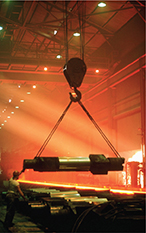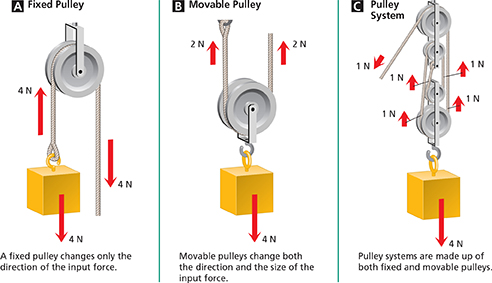Pulleys
A construction worker needs to lift a load of roofing materials onto the roof where he is working. Because it is easier and safer, he uses a pulley system to lift the load. The pulley system allows him to pull with less force than is needed to lift the load directly upward.
A pulley is a simple machine that consists of a rope that fits into a groove in a wheel. Pulleys produce an output force that is different in size, direction, or both, from that of the input force.  The ideal mechanical advantage of a pulley or pulley system is equal to the number of rope sections supporting the load being lifted. Part of a pulley system is shown in Figure 18.
The ideal mechanical advantage of a pulley or pulley system is equal to the number of rope sections supporting the load being lifted. Part of a pulley system is shown in Figure 18.
Figure 18 A worker watches as a pulley moves a large fabricated part through a factory. Interpreting Photos Based on what can be seen in the photograph, what is the approximate mechanical advantage of the pulley being used?

Fixed Pulleys
A fixed pulley is a wheel attached in a fixed location. Fixed pulleys are only able to rotate in place. The direction of the exerted force is changed by a fixed pulley, but the size of the force is not. If you use the fixed pulley shown in Figure 19A, the rope or chain lifts the load up as far as you pull down the rope. Thus, the ideal mechanical advantage of a fixed pulley is always 1. Assuming friction forces are small, the input force and output force will be the same. Examples of fixed pulleys include the pulley at the top of a flagpole and the pulleys used to pull up blinds.





